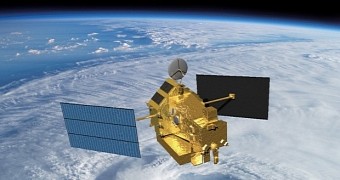This past Tuesday, a decrepit satellite fell from orbit and came tumbling down to Earth. The satellite caught fire and was almost completely destroyed while journeying through the planet's atmosphere.
Scientists who witnessed its demise estimate that merely a dozen or so bits and pieces of the lost craft survived the blaze and were swallowed by the waters of the South Indian Ocean.
In a statement, NASA says that the satellite found its way back into our planet's atmosphere at 03:55 UTC (Coordinated Universal Time). The craft had been dead for a while and so the crash was not a surprise.
“A long-serving Earth observation satellite has succumb to a fiery demise via an uncontrolled destructive re-entry on Tuesday,” researchers with the space agency explain.
“The Tropical Rainfall Measuring Mission (TRMM) spacecraft - a joint mission of NASA and JAXA [Japan's Aerospace Exploration Agency] - re-entered Earth’s atmosphere at 03:55 am UTC,” they add.
When still alive and in one piece, the satellite tipped the scale at about 3 tons. Even so, NASA was never really worried that it might end up injuring people when falling from the sky.
Prior to yesterday's crash, specialists tracking the craft's movements in Earth's orbit had calculated that the odds that debris produced by the satellite could hit a person were 1 in 4,200.
The satellite had a much longer life than expected
The Tropical Rainfall Measuring Mission satellite that crashed back to Earth this past June 16 was launched aboard a Japanese H-II rocket in November 1997.
The craft was put in our planet's orbit to monitor and document global rainfall patterns. The data it produced while circling Earth was made available to climate and weather scientists.
With the help of this satellite, researchers gained a better understanding of tropical cyclones, lightning-storms, and the impact that human activities can have on rainfall across the world.
“The value of the new type of precipitation data produced by TRMM is widely recognized by both the scientific community and the operational weather forecast community,” NASA says.
Interestingly, the Tropical Rainfall Measuring Mission satellite was expected to remain operational for just 3 years. Still, it managed to hold on for 17 years instead.
The satellite was shut down by NASA scientists and fellow researchers at the Aerospace Exploration Agency in Japan back in April. Having switched it off, they merely waited for it to fall.
Yesterday's crash aside, NASA last lost a satellite in September 2011. Then, it was the agency's Upper Atmosphere Research Satellite that fell from grace and crashed in the Pacific Ocean.

 14 DAY TRIAL //
14 DAY TRIAL //